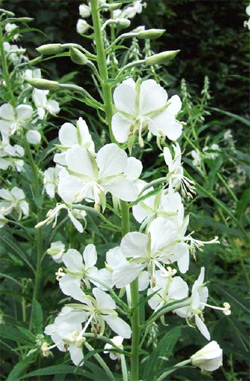|
White Willow
 Anti-inflammatory, analgesic, reduces fever, anti-rheumatic,
astringent. White willow is the original source of salycilic acid, the
forerunner of aspirin. Extremely effective for reducing
joint, hip, and back pain caused by rheumatism and arthritis. In
combination with other herbs and dietary changes, it relieves inflammation
and swelling, and improves mobility in painful, creaky joints. Also used to
manage high fevers and may be used to ease headaches. White willow assists
during menopause by reducing
sweating during hot flashes and night sweats. Anti-inflammatory, analgesic, reduces fever, anti-rheumatic,
astringent. White willow is the original source of salycilic acid, the
forerunner of aspirin. Extremely effective for reducing
joint, hip, and back pain caused by rheumatism and arthritis. In
combination with other herbs and dietary changes, it relieves inflammation
and swelling, and improves mobility in painful, creaky joints. Also used to
manage high fevers and may be used to ease headaches. White willow assists
during menopause by reducing
sweating during hot flashes and night sweats.
Salix alba
Activated charcoal powder, made from kiln burned white willow logs, has
long been recommended as an efficient antidote for prescription and
over-the-counter drug poisonings, diarrhea, gas, heartburn and other
general gastrointestinal distress. Stir one tablespoonful of charcoal
powder, one teaspoonful of powdered ginger root, and 1/2 teaspoon white
sugar in one large glass distilled water and drink. Repeat as necessary.
Parts Used
Bark, leaves.
Uses
Past uses - White willow is astringent and was formerly used to
staunch internal bleeding. In his herbal (1652), Nicholas Culpeper
advised that the burnt ashes of the bark be "mixed with vinegar, [to]
take away warts, corns and superfluous flesh."
Joint remedy - White willow is an excellent remedy for arthritic
and rheumatic pain affecting the back, and joints such as the knees and
hips. In combination with other herbs and dietary changes, white willow
relieves inflammation and swelling, and improves mobility in painful or
creaky joints. Though aspirin-based conventional medicines are stronger
acting, they can have unwanted side effects.
Fevers & pain - White willow is taken to manage high fevers.
White willow may also be used to ease headaches and head pain.
Menopause - By reducing sweating, white willow helps hot flashes and
night sweats.
Other Uses - Osteoarthritis
|

